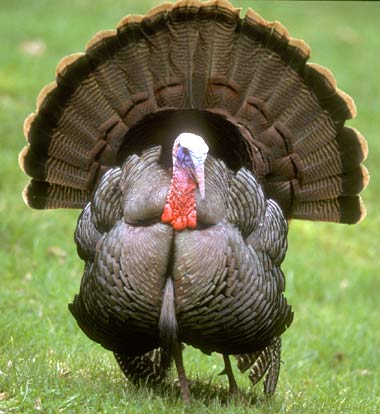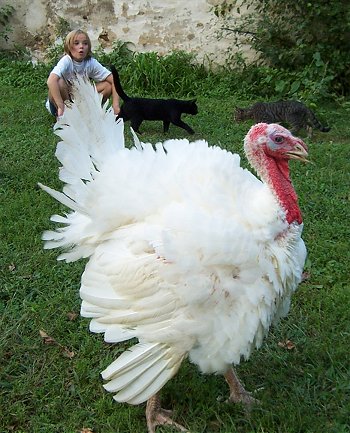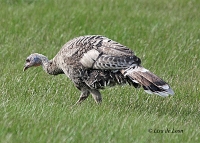 The wild turkey is sexually dimorphic with the males being larger and looking much different than the females. The males have a tiny red and blue head with a distinctive red wattle and large, bristly black beard. Its feathers are beautiful iridescent browns, greens and reds. The female (pictured below at right) is smaller in size, duller in color, and usually lacks the beard. The male can weigh up to 20 pounds and measure four feet tall while the female can grow to nearly the same height and weigh between 12 and 14 pounds. Both the male and female have a “snood” or fleshy protrusion resting on there forehead.
The wild turkey is sexually dimorphic with the males being larger and looking much different than the females. The males have a tiny red and blue head with a distinctive red wattle and large, bristly black beard. Its feathers are beautiful iridescent browns, greens and reds. The female (pictured below at right) is smaller in size, duller in color, and usually lacks the beard. The male can weigh up to 20 pounds and measure four feet tall while the female can grow to nearly the same height and weigh between 12 and 14 pounds. Both the male and female have a “snood” or fleshy protrusion resting on there forehead.
 Wild turkeys are fairly common despite being an often-hunted game bird. They are increasing in numbers and range, moving most recently into suburban areas. The wild turkey lives in forested areas adjacent to open clearings. They roam in flocks and are often seen wandering nonchalantly along roadsides or developed areas. The polygamous male mates with many females in a breeding season. His statuesque breeding display is the symbol we commonly associate with American Thanksgiving. The display (pictured at top) can be identified when the male puffs up his chest and raises his lovely tail feathers. This is also when the male typically vocalizes the quintessential turkey “gobble."
Wild turkeys are fairly common despite being an often-hunted game bird. They are increasing in numbers and range, moving most recently into suburban areas. The wild turkey lives in forested areas adjacent to open clearings. They roam in flocks and are often seen wandering nonchalantly along roadsides or developed areas. The polygamous male mates with many females in a breeding season. His statuesque breeding display is the symbol we commonly associate with American Thanksgiving. The display (pictured at top) can be identified when the male puffs up his chest and raises his lovely tail feathers. This is also when the male typically vocalizes the quintessential turkey “gobble."
Wild turkeys are opportunistic feeders, feeding on seasonal foods ranging from berries and seeds to insects and flowers. In the winter they will eat an assortment of nuts and grains to build fat reserves for the breeding season. At this time, females will also eat large quantities of calcium-rich foods such as snails to help with egg production.
The wild turkey had special significance to Native Americans, puritans and early American settlers; however unregulated hunting and habitat destruction nearly led to its demise by the end of the 18th century. By 1881, there were no turkeys left in the state of Wisconsin. Conservation efforts set forth in the early 1900’s, along with the gift of a population of 29 Missouri turkeys sent over in the 1970’s, helped to return this bird to its former glory. Today the wild turkey is widespread throughout the state and thriving.
Fun Facts:
- Turkeys commonly partake in a ritual called dusting. They kick and coat themselves in dirt and dust to remove parasites from their bodies. Click here to watch a video of this entertaining ritual.
- You may know that the turkey was Benjamin Franklin’s first choice for the national bird, but have you ever read his correspondence as to why he felt that way? This letter, written by Mr. Franklin to his daughter, explains why he thought the bald eagle poorly represented the United States as a national symbol.
- Wild turkeys (not domestic) are actually pretty good fliers. This video beautifully demonstrates their flight.
- Did you know most states actually have an annual turkey calling and gobbling contest? Click here to watch this hilarious video of well-known gobbler, Preston Pittman.





